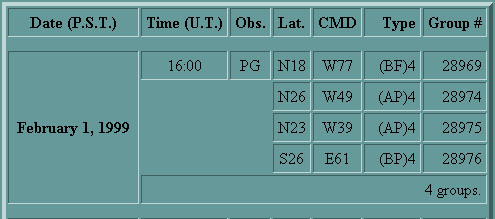
Monthly Sunspot Report Legend
 |
The 150-Foot Solar Tower Monthly Sunspot Report Legend |

PG is Pamela Gilman.
CG is Colleen Gino.
SP is Steve Padilla.
TS is Tom Shieber.
LW is Larry Webster.
LK is Lynn Koneiwitz.
AP = alpha p
All the magnetic measures in the group are of the same magnetic polarity which is that corresponding to the preceding spots in that hemisphere for that cycle.
AF = alpha f
All the magnetic measures in the group are of the same magnetic polarity which is that corresponding to the following spots in that hemisphere for that cycle.
B = beta
A bipolar group in which the magnetic measures indicate a balance between the preceding and following spots.
BP = beta p
A bipolar group in which the magnetic measures indicate that the preceding spots are dominant (factor of 2 or more).
BF = beta f
A bipolar group in which the magnetic measures indicate that the following spots are dominant (factor of 2 or more).
BG = beta gamma
A group which has general beta characteristics but in which one or more spots are out of place as far as the polarities are concerned.
G = gamma
A group in which the polarities are completely mixed.
D* = delta
Will be added to the above classifications if the group is also of the "delta-configuration": spot umbrae of opposite polarity within 2 degrees of one another and within the same penumbra.
+ = reverse polarity group
A plus sign will be added after the magnetic classification if the group polarities do not follow the general law of sunspot polarity for the hemisphere.
Code and Maximum Field Strength in Gauss
1 = 100-500
2 = 600-1000
3 = 1100-1500
4 = 1600-2000
5 = 2100-2500
6 = 2600-3000